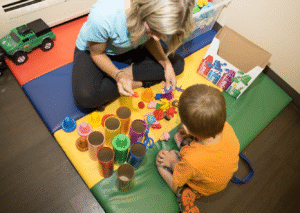Torticollis, often referred to as “wry neck,” is a condition characterized by a baby’s head tilting to one side while the chin tilts to the opposite side. This occurs when the sternocleidomastoid muscle in the neck becomes tight, shortened, or weakened, causing limited movement and discomfort.
While the diagnosis of torticollis can be concerning for parents, the good news is that physical therapy offers an effective, non-invasive treatment to address this condition. Read on to learn more about torticollis and how physical therapy helps infants achieve proper alignment and movement.
Understanding Torticollis
Torticollis can be categorized into two types:
- Congenital Torticollis: This form is present at birth and often linked to positioning in the womb or a difficult delivery. It may result in a tight or shortened neck muscle on one side, leading to restricted movement.
- Acquired Torticollis: This type develops later, possibly due to muscle strain, injury, or other medical conditions.
In infants, torticollis is frequently accompanied by plagiocephaly, a flat spot on the head, due to the baby’s tendency to rest in one position. Early intervention prevents complications and promotes proper motor development.
Signs and Symptoms of Torticollis
Parents may notice signs of torticollis in their infant, such as:
- A consistent tilt of the head to one side.
- Difficulty turning the head fully in both directions.
- A preference for looking in one direction.
- Flattening of one side of the head (plagiocephaly).
- Uneven shoulders or restricted neck movement.
If you observe these signs, consulting with your pediatrician is the first step, followed by a referral to a pediatric physical therapist.
How Physical Therapy Treats Torticollis
Physical therapy provides personalized exercises and techniques that address the root cause of the condition. Here’s how physical therapy helps:
- Stretching Tight Muscles
Physical therapists use gentle, guided stretches to lengthen the shortened neck muscle, improving range of motion and alignment. These stretches are tailored to your baby’s specific needs and are safe when performed under professional supervision.
- Strengthening Weak Muscles
To balance the neck muscles, therapists introduce exercises that strengthen the weaker side. This helps the baby maintain proper head alignment and enhances overall neck stability.
- Encouraging Symmetrical Movement
Physical therapy promotes symmetrical movement by encouraging the baby to turn their head in both directions during play and everyday activities. Therapists may use toys, mirrors, or other engaging tools to motivate the baby to move freely.
- Promoting Proper Positioning
Therapists guide parents on positioning techniques that help reduce pressure on the baby’s head and neck. These include tummy time, repositioning during sleep, and varying the baby’s feeding position.
- Parent Education and Home Exercises
Physical therapy sessions empower parents with the knowledge and tools to continue exercises at home. Consistent practice outside of therapy sessions is key to achieving optimal results.
Craniosacral Therapy for Torticollis
While physical therapy is often the primary treatment, craniosacral therapy (CST) is an effective complementary approach used alongside physical therapy. This gentle, hands-on technique focuses on releasing tension in the craniosacral system, which includes the skull, spine, and sacrum. For infants with torticollis, CST offers a non-invasive method to reduce discomfort and improve alignment.
Craniosacral therapy is a specialized form of manual therapy that uses light touch to assess and release restrictions in the craniosacral system. This system surrounds the brain and spinal cord and influences the flow of cerebrospinal fluid, which plays a vital role in the nervous system’s function. By gently manipulating the skull, neck, and spine, CST helps release tension, improve circulation, and promote the body’s natural healing processes.
How Craniosacral Therapy Helps Torticollis
CST addresses the underlying factors contributing to torticollis, such as muscle tension, fascial restrictions, and misalignments in the craniosacral system. Here’s how CST can benefit infants with torticollis:
- Releasing Muscle and Fascia Tension
Torticollis is often linked to tightness in the sternocleidomastoid muscle and surrounding fascia. Craniosacral therapists use gentle techniques to release tension in these areas, improving the range of motion in the neck.
- Improving Head and Neck Alignment
Misalignments in the cranial bones or upper cervical spine can exacerbate torticollis. CST helps restore proper alignment by releasing restrictions in these areas, allowing the head and neck to move freely.
- Relieving Compression from Birth Trauma
Many cases of torticollis result from birth trauma, such as a difficult delivery or time spent in a constrained position in the womb. CST addresses residual tension or compression in the cranial and spinal structures caused by these factors, reducing discomfort and aiding recovery.
- Enhancing Nervous System Function
CST promotes relaxation and balances the autonomic nervous system, which can reduce irritability and discomfort often associated with torticollis.
- Complementing Other Therapies
CST works well alongside physical therapy, enhancing the effects of stretching and strengthening exercises by creating a more relaxed and aligned foundation.
Benefits of Physical and Craniosacral Therapy for Torticollis
Improved Range of Motion: Physical therapy restores the baby’s ability to move their head freely and comfortably in all directions.
- Balanced Muscle Strength: Strengthening weak muscles ensures proper posture and alignment as the baby grows.
- Prevention of Long-Term Issues: Early intervention minimizes the risk of developmental delays, head shape asymmetry, and other complications.
- Enhanced Motor Development: By addressing torticollis early, babies can reach important milestones like rolling, sitting, and crawling on time.
- Gentle and Safe: CST is a non-invasive technique suitable for even the youngest infants.
- Supports Holistic Development: By improving neck mobility, CST helps infants reach developmental milestones like rolling, sitting, and crawling.
- Alleviates Associated Conditions: CST may also address related issues like feeding difficulties or plagiocephaly (flattened head) often seen in babies with torticollis.
- Reduces Discomfort: By releasing tension and misalignments, CST can improve comfort and reduce fussiness in affected infants.

What to Expect During a Craniosacral Therapy Session
The therapist will evaluate the baby’s head and neck alignment, range of motion, and areas of tension. Using extremely light pressure (comparable to the weight of a nickel), the therapist will apply techniques to release restrictions and encourage relaxation. Sessions are designed to accommodate the baby’s comfort and mood, often incorporating play or soothing techniques.
While craniosacral therapy can significantly benefit infants with torticollis, it’s most effective when integrated with physical therapy for a comprehensive treatment plan. Early treatment is crucial for the best outcomes. The sooner torticollis is addressed, the easier it is to correct. Physical therapy can start as early as a few weeks old, and most babies respond well to consistent care and exercises.
Your Partner in Torticollis Care
At Crawl Walk Jump Run Therapy Clinic, we provide specialized care for infants with torticollis. Our skilled team combines physical therapy with gentle craniosacral therapy to release tension, restore balance, and support your baby’s development. Certified pediatric therapists work closely with families to ensure the best outcomes, helping your baby grow with confidence.
If you’re concerned about your baby’s neck or head movement, don’t wait—call us at (586) 323-2957 to schedule an evaluation and start their journey to improved mobility and comfort.




